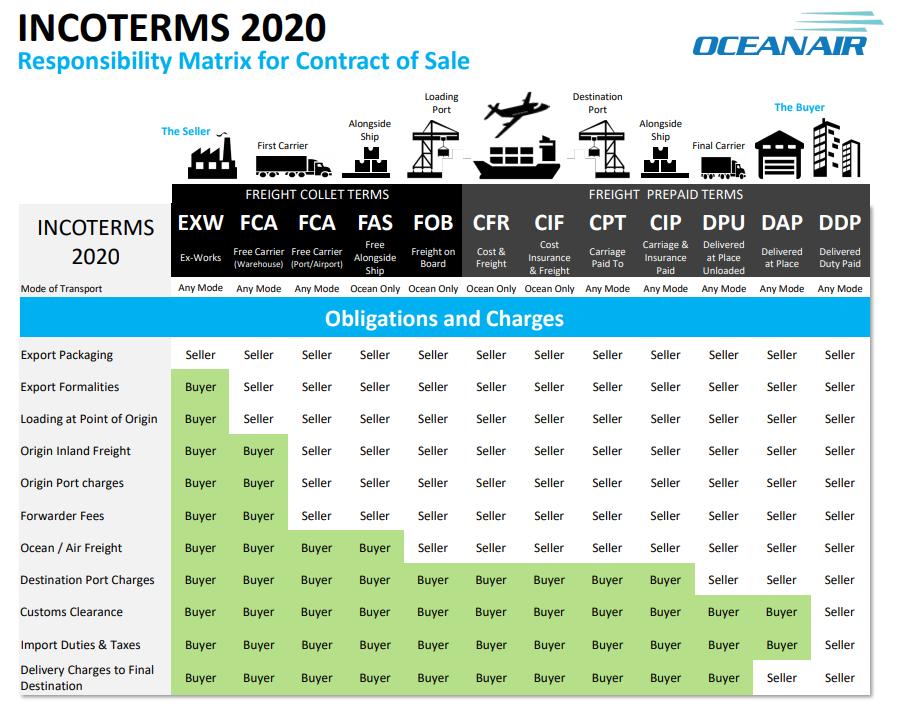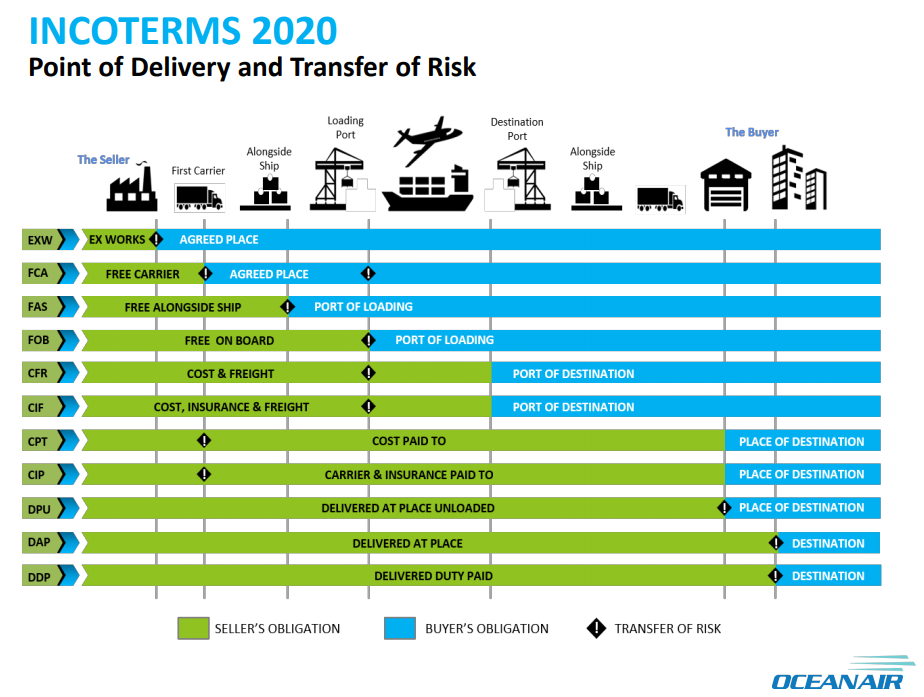As an ecommerce retailer, small or large, you will have a supply chain that likely spans the globe to a lesser or greater degree. Whether you are aware of this or not, ultimately the products you’re purchasing have likely been made outside of the UK. If you’re new to the import/export game then you’ll likely be as confused as everyone else when it comes to how things are shipped around the world and what all the terminology means. This blog post is designed to be a handy resource to simplify the import/export game and terminology so you can get up and running importing and exporting your products with ease.
What are Incoterms?
Simply put, Incoterms is the abbreviation of what is called International Commercial Terms. In other words, a common vocabulary used around the world to explain who is responsible for what and ultimately who holds the risk at the different stages of the shipping process. So we know who to speak to when things don’t quite go according to plan, and if anything is guaranteed, it is that things don’t always go to plan.
For smaller quantities of goods being shipped around the world, you may not need to worry about the finer details of this as it is likely encapsulated within the costs you are paying – but it is always worth being diligent in this area as even when small orders ‘go missing’ you’ve got to take into account the products you’ll need to sell and the profit you need to make to recover this cost through additional sales.
As your order quantities grow, you’re going to want to keep a close eye on Incoterms when dealing with multiple suppliers and customers around the globe. Getting things wrong can be an extremely costly mistake to make.
Understanding Incoterms
The images in this post are referenced to international logistics company OceanAir who have done an excellent job at creating the infographics to simplify these terms into an easy to digest image – once you understand what the terms actually mean. So let’s dig into the terminology first before we look at the images.
One of the common terms that you’ll read throughout the incoterms is a freight forwarder. But what exactly is a freight forwarder? In simple terms, a freight forwarder is a common courier that doesn’t operate shipping vessels.
EX-Works
One of the simplest and most basic shipment arrangements places the minimum responsibility on the seller with greater responsibility on the buyer. In an EX-Works transaction, goods are basically made available for pickup at the shipper/seller’s factory or warehouse and “delivery” is accomplished when the merchandise is released to the consignee’s freight forwarder. The buyer is responsible for making arrangements with their forwarder for insurance, export clearance and handling all other paperwork.
FOB (Free On Board)
FOB means that the shipper/seller uses their freight forwarder to move the merchandise to the port or designated point of origin. Though frequently used to describe inland movement of cargo, FOB specifically refers to ocean or inland waterway transportation of goods. “Delivery” is accomplished when the shipper/seller releases the goods to the buyer’s forwarder. The buyer’s responsibility for insurance and transportation begins at the same moment.
FCA (Free Carrier)
In this type of transaction, the seller is responsible for arranging transportation, but he is acting at the risk and the expense of the buyer. Where in FOB the freight forwarder or carrier is the choice of the buyer, in FCA the seller chooses and works with the freight forwarder or the carrier. “Delivery” is accomplished at a predetermined port or destination point and the buyer is responsible for Insurance.
FAS (Free Alongside Ship)
In these transactions, the buyer bears all the transportation costs and the risk of loss of goods. FAS requires the shipper/seller to clear goods for export, which is a reversal from past practices. Companies selling on these terms will ordinarily use their freight forwarder to clear the goods for export. “Delivery” is accomplished when the goods are turned over to the Buyers Forwarder for insurance and transportation.
CFR (Cost and Freight)
This term formerly known as CNF (C&F) defines two distinct and separate responsibilities-one is dealing with the actual cost of merchandise “C” and the other “F” refers to the freight charges to a predetermined destination point. It is the shipper/seller’s responsibility to get goods from their door to the port of destination. “Delivery” is accomplished at this time. It is the buyer’s responsibility to cover insurance from the port of origin or port of shipment to buyer’s door. Given that the shipper is responsible for transportation, the shipper also chooses the forwarder.
CIF (Cost, Insurance and Freight)
This arrangement similar to CFR, but instead of the buyer insuring the goods for the maritime phase of the voyage, the shipper/seller will insure the merchandise. In this arrangement, the seller usually chooses the forwarder. “Delivery” as above, is accomplished at the port of destination.
CPT (Carriage Paid To)
In CPT transactions the shipper/seller has the same obligations found with CIF, with the addition that the seller has to buy cargo insurance, naming the buyer as the insured while the goods are in transit.
CIP (Carriage and Insurance Paid To)
This term is primarily used for multimodal transport. Because it relies on the carrier’s insurance, the shipper/seller is only required to purchase minimum coverage. When this particular agreement is in force, Freight Forwarders often act in effect, as carriers. The buyer’s insurance is effective when the goods are turned over to the Forwarder.
DAF (Delivered At Frontier)
Here the seller’s responsibility is to hire a forwarder to take goods to a named frontier, which usually a border crossing point, and clear them for export. “Delivery” occurs at this time. The buyer’s responsibility is to arrange with their forwarder for the pick up of the goods after they are cleared for export, carry them across the border, clear them for importation and effect delivery. In most cases, the buyer’s forwarder handles the task of accepting the goods at the border across the foreign soil.
DES (Delivered Ex Ship)
In this type of transaction, it is the seller’s responsibility to get the goods to the port of destination or to engage the forwarder to the move cargo to the port of destination uncleared. “Delivery” occurs at this time. Any destination charges that occur after the ship is docked are the buyer’s responsibility.
DEQ (Delivered Ex Quay)
In this arrangement, the buyer/consignee is responsible for duties and charges and the seller is responsible for delivering the goods to the quay, wharf or port of destination. In a reversal of previous practice, the buyer must also arrange for customs clearance.
DDP (Delivered Duty Paid)
DDP terms tend to be used in intermodal or courier-type shipments. Whereby, the shipper/seller is responsible for dealing with all the tasks involved in moving goods from the manufacturing plant to the buyer/consignee’s door. It is the shipper/seller’s responsibility to insure the goods and absorb all costs and risks including the payment of duty and fees.
DDU (Delivered Duty Unpaid)
This arrangement is basically the same as with DDP, except for the fact that the buyer is responsible for the duty, fees and taxes.
Incoterms Simplified Images
Below are a couple of handy diagrams to show the above incoterms and how they differ from each other.


International Shipping
Clearly international shipping is an extremely complex area and this blog post only gives a very brief overview for common international commercial terms in relation to shipping. Hopefully this at least helps you to understand where your potential risks lie whenever you’re importing or exporting goods around the world.
Michael Cropper
Latest posts by Michael Cropper (see all)
- WGET for Windows - April 10, 2025
- How to Setup Your Local Development Environment for Java Using Apache NetBeans and Apache Tomcat - December 1, 2023
- MySQL Recursive Queries – MySQL While Loops – Fill Zero Sum Dates Between Dates - October 6, 2023
